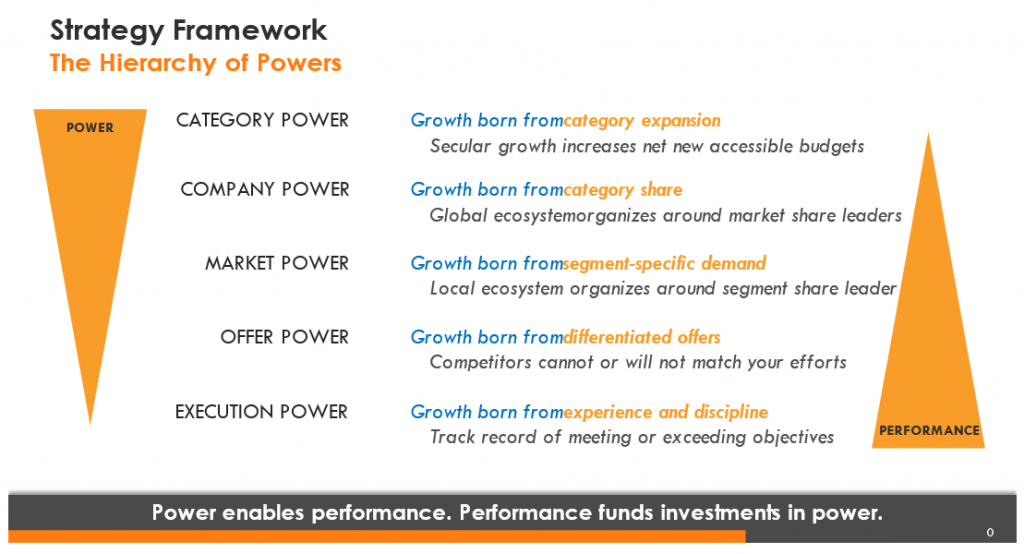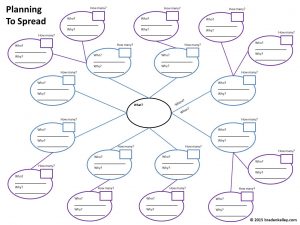
GUEST POST from Geoffrey A. Moore
Fall is in the air, which brings to mind the season’s favorite sport—no, not football, strategic planning! Let’s face it, 2023 has been a tough year for most of us, with few annual plans surviving first contact with an economy that was not so much sluggish as simply hesitant. With the exception of generative AI’s burst onto the scene, most technology sectors have been more or less trudging along, and that begs the question, what do we think we can do in 2024? Time to bring out the strategy frameworks, polish up those crystal balls that have been a bit murky of late, and chart our course forward.
This post will kick off a series of blogs about framing strategy, all organized around a meta-model we call the Hierarchy of Powers:

The inspiration for this model came from looking at how investors prioritize their portfolios. The first thing they do is allocate by sector, based primarily on category power, referring both to the growth rate of the category as well as its potential size. Rising tides float all boats, and one of the toughest challenges in business is how to manage a premier franchise when category growth is negative. In conjunction with assessing our current portfolio’s category power, this is also a time to look at adjacent categories, whether as threats or as opportunities, to see if there are any transformative acquisitions that deserve our immediate attention.
Returning to our current set of assets, within each category the next question to answer is, what is our company power within that category? This is largely a factor of market share. The more share a company has of a given category, the more likely the ecosystem of partners that supports the category will focus first on that company’s installed base, adding more value to its offers, as well as to recommend that company’s products first, again because of the added leverage from partner engagement. Marketplaces, in other words, self-organize around category leaders, accelerating the sales and offloading the support costs of the market share leaders.
But what do you do when you don’t have company power? That’s when you turn your attention to market power. Marketplaces destabilize around problematic use cases that the incumbent vendors do not handle well. This creates openings for new entrants, provided they can authentically address the customer’s problems. The key is to focus product management on the whole product (not just what your enterprise supplies, but rather, everything the customer needs to be successful) and to focus your go-to-market engine on the target market segment. This is the playbook that has kept Crossing the Chasm on entrepreneur’s book lists some thirty years in, but it is a different matter to execute it in a large enterprise where sales and marketing are organized for global coverage, not rifle-shot initiatives. Nonetheless, when properly executed, it is the most reliable play in all of high-tech market development.
If market power is key to taking market share, offer power is key to maintaining it, both in high-growth categories as well as mature ones. Offer power is a function of three disciplines—differentiation to create customer preference, neutralization to catch up to and reduce a competitor’s differentiation, and optimization to eliminate non-value-adding costs. Anything that does not contribute materially to one of these three outcomes is waste.
Finally, execution power is the ability to take advantage of one’s inertial momentum rather than having it take advantage of you. Here the discipline of zone management has proved particularly valuable to enterprises who are seeking to balance investment in their existing lines of business, typically in mature categories, with forays into new categories that promise higher growth.
In upcoming blog posts I am going to dive deeper into each of the five powers outlined above to share specific frameworks that clarify what decisions need to be made during the strategic planning process and what principles can best guide them. In the meantime, there is still one more quarter in 2023 to make, and we all must do our best to make the most of it.
That’s what I think. What do you think?
Image Credit: Pixabay, Geoffrey A. Moore
![]() Sign up here to join 17,000+ leaders getting Human-Centered Change & Innovation Weekly delivered to their inbox every week.
Sign up here to join 17,000+ leaders getting Human-Centered Change & Innovation Weekly delivered to their inbox every week.


 But, an idea can be built to spread.
But, an idea can be built to spread.
